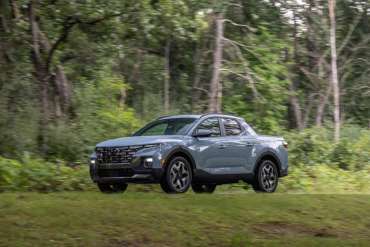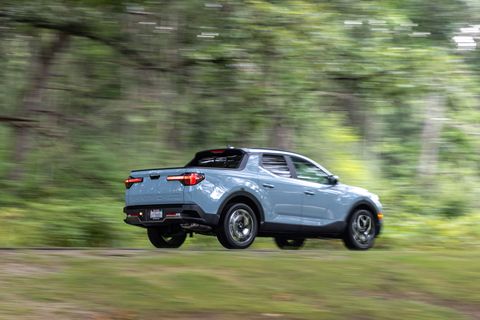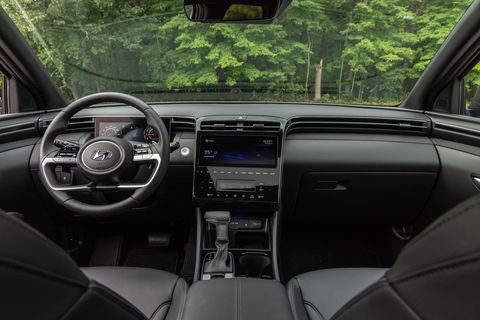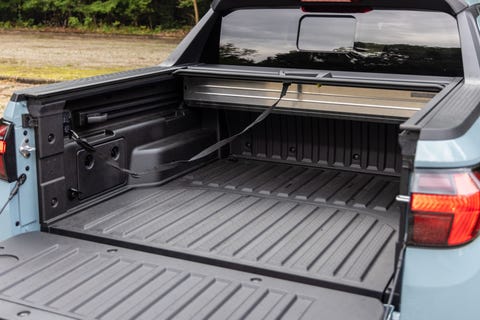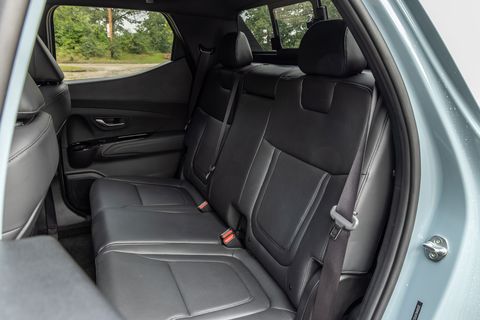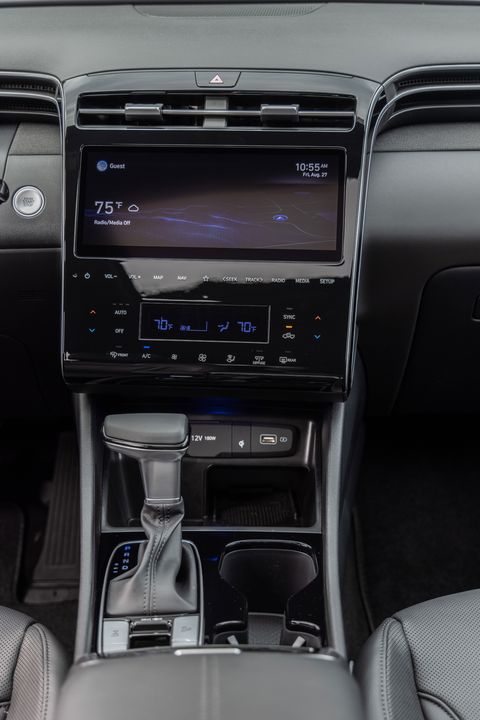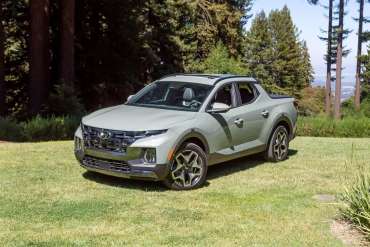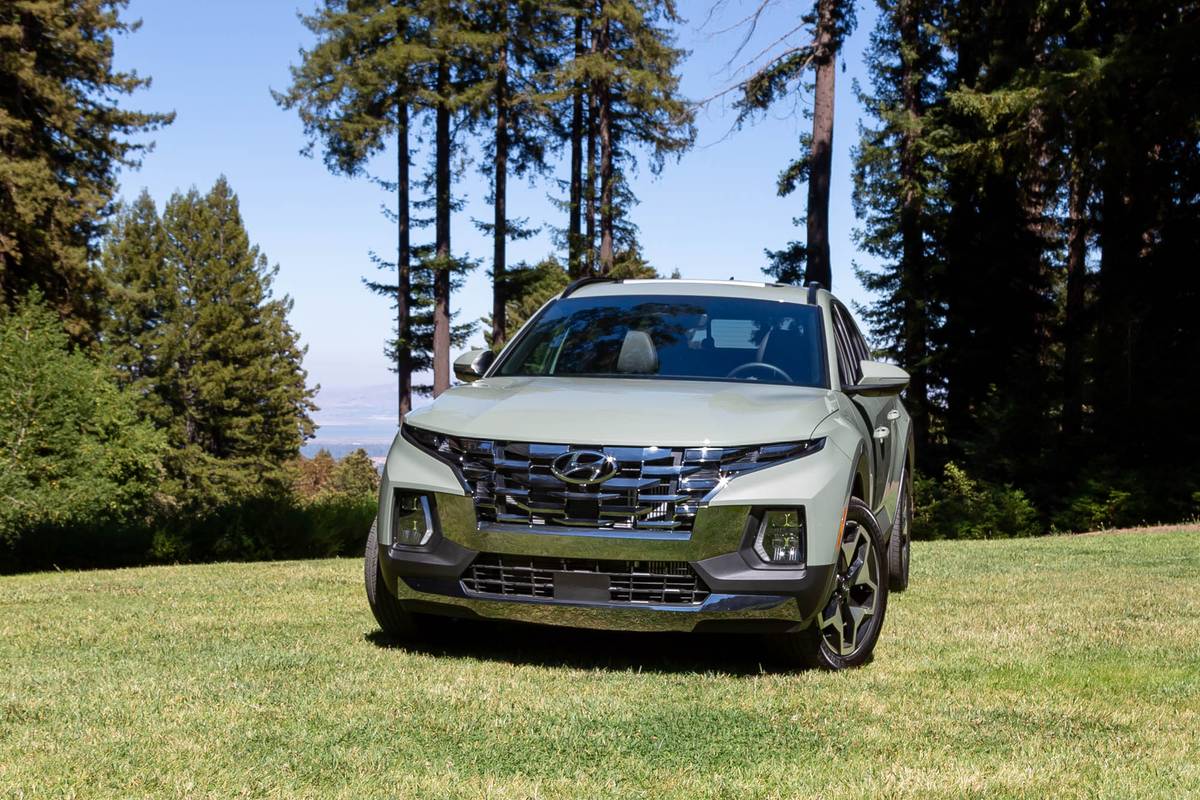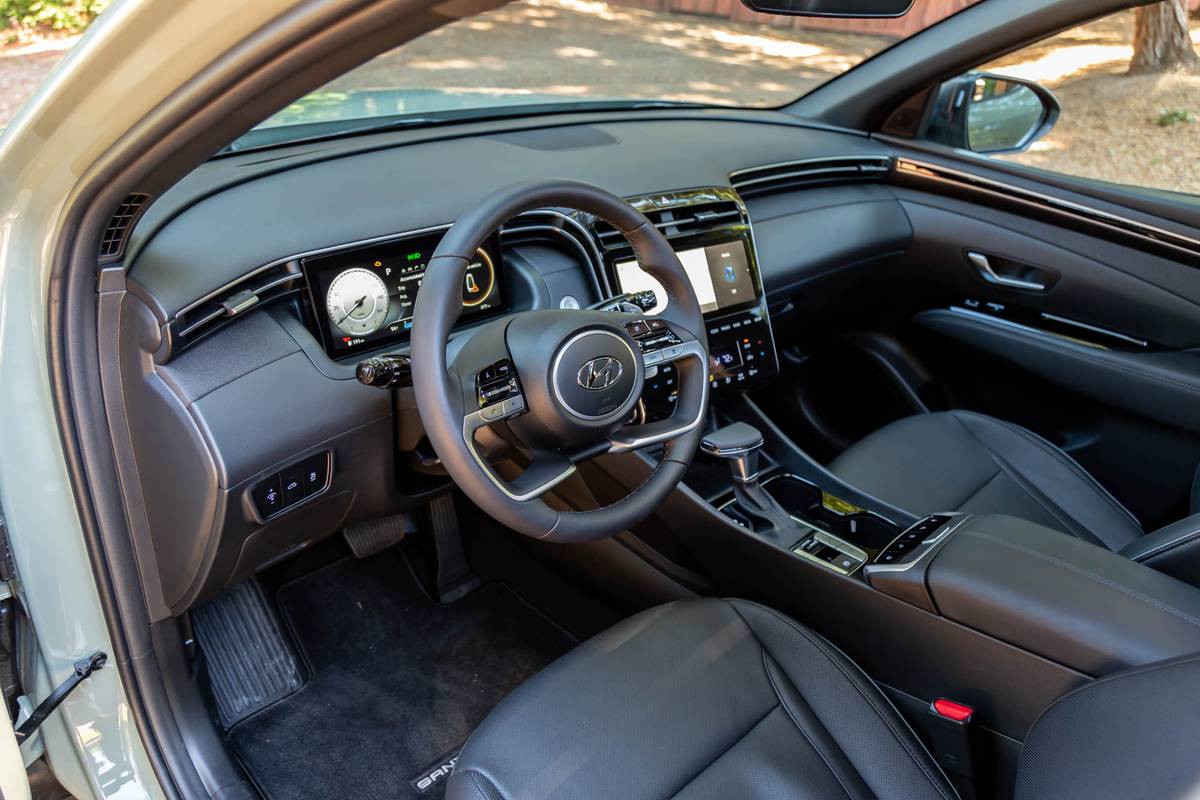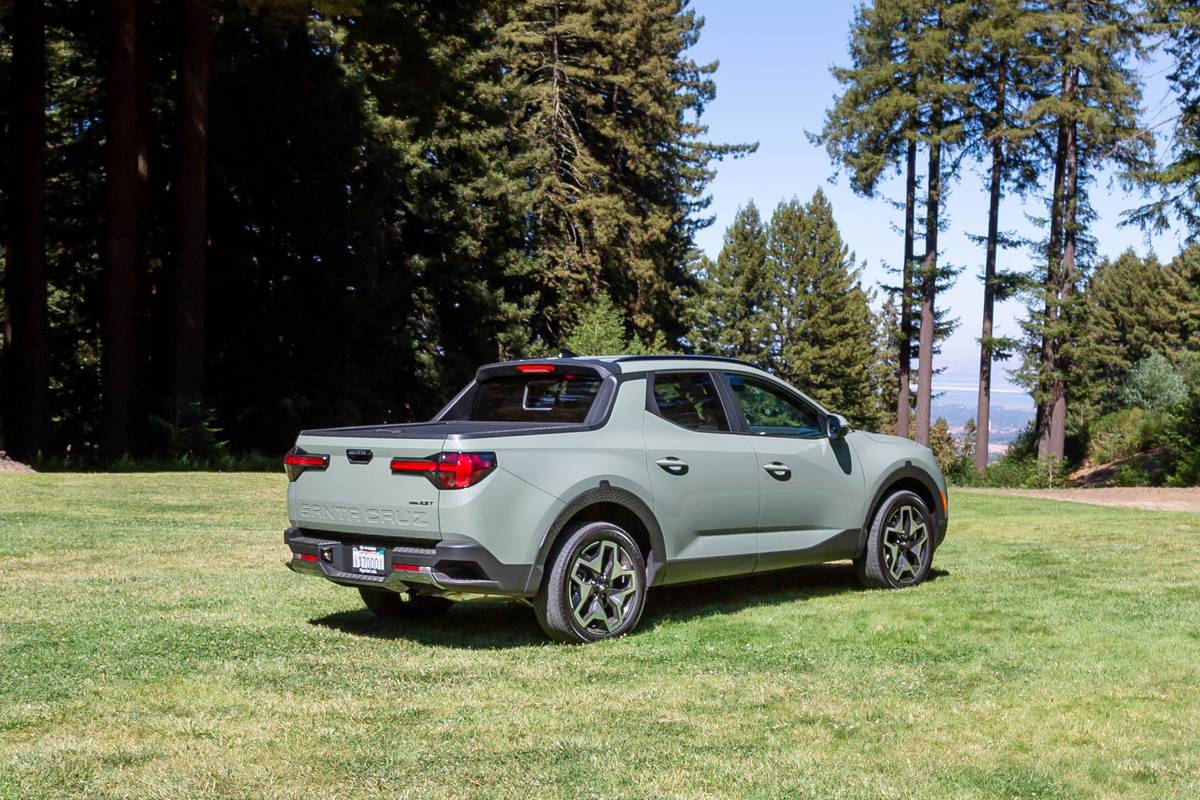Versus the competition: We haven’t yet driven the 2022 Ford Maverick, the other new compact pickup on the block, but we’ve been impressed by what we’ve seen thus far. The Santa Cruz takes a more premium and unconventional tack, but it seems more likely to face competition both from Hyundai and other brands’ compact and mid-size SUVs rather than traditional (or less traditional) pickups.
We’ve been teased by the idea of a Hyundai pickup truck for years and now, finally, here it is: the 2022 Hyundai Santa Cruz. Except … Hyundai won’t call it a pickup. No, the Santa Cruz is a Sport Adventure Vehicle, according to the automaker (Not to be confused with Sport Activity Vehicle, which is what BMW has always called its SUVs). But I’m going to let you in on a little secret. Come closer. Closerrrrr. OK, ready for the secret?
It’s a pickup.
It’s a pickup in my book, anyway. If a vehicle has a pickup bed, it’s a pickup. (I will not be discussing whether a hot dog is a sandwich or if cereal and milk is soup.) That’s by no means a bad thing; we’re very excited about another unibody compact pickup truck, the 2022 Ford Maverick, and the less traditional unibody Honda Ridgeline is consistently a top finisher, if not a winner, in our mid-size pickup comparison tests.
The Santa Cruz looks even less like a pickup than the Maverick or Ridgeline, appearing to be more of a mid-size SUV with a bed. And between its looks and Hyundai’s unwillingness to call it a pickup truck, I have a feeling the Santa Cruz is going to be a more competitive choice among SUV shoppers, not those looking for a pickup — and having now driven one, I find the Santa Cruz a strange-looking but compelling choice.
Small in Size, Trick in Features Outside
Visually, the Santa Cruz is something of a compact, modern Chevrolet Avalanche, though I will say I don’t think photos do it justice. It’s much more appealing in person, if a bit unusual-looking. I also appreciate that while the sides of the Santa Cruz have some sharp, sculpted lines, it doesn’t have the “pre-dented” look of Hyundai’s Elantra sedan or Tucson SUV.
What the Santa Cruz also lacks, at least in the realm of pickups, is size. It’s 4 inches shorter from bumper to bumper than the Ford Maverick and more than a foot shorter than the Honda Ridgeline. We’ve done a more thorough breakdown of its size elsewhere, which you should check out, but the key takeaway is this: It doesn’t look big.
The Santa Cruz’s bed itself also isn’t big, at just over 4 feet long when the tailgate is closed and more than 6 feet long with the tailgate completely lowered. The tailgate can also take up a middle position to provide support for carrying 4-by-8-foot sheets of plywood or drywall. Bed depth is 19.2 inches, and width varies from nearly 54 inches at its widest to almost 43 inches between the wheel housings.
To make up for the bed’s small size (even though it’s likely enough bed for the average consumer), Hyundai added a number of trick features. Most noticeable is a factory-installed integrated retractable tonneau cover (not available with the base SE trim, but available on the SEL and standard on the SEL Premium and Limited), which opens and closes easily. There’s also a strap attached to the cover to help pull it closed; in our test vehicle, it was clipped to the bed to keep the strap from getting lost in the back of the bed, though I wonder what the best way to store it would be if the bed were full of items. If it stays clipped, it could get in the way; unclipped, it might get lost in the cargo.
The bed also has a lockable underfloor storage compartment with drain plugs, which is truly another signifier that the Santa Cruz is a pickup: Owners can take it to a tailgate party and fill one of its compartments with ice and six-packs of b … sodas. There are additional lockable side compartments, one of which can be equipped with an optional 115-volt, low-current power outlet as well as LED lighting above the bed and on each side. To improve bed access, there are steps built into the corners of the rear bumper. Numerous factory and aftermarket accessories will also be available.
All of this utility might not be enough to sway pickup purists, but a Santa Fe with a lockable and more durable rear cargo area is an enticing proposition.
Hyundai also placed numerous visual “Easter eggs” on the Santa Cruz’s exterior, though they’re not very well hidden. There are Santa Cruz silhouettes on the fender moldings, rear bumper molding and on the molding atop the bed sides.
A Counterintuitive Cabin Inside
Inside the Santa Cruz, you’ll find some modern Hyundai hallmarks. Materials quality was decent and felt slightly upscale in the top-of-the-line Limited I drove, and the control layout is intuitive. Hyundai even gave the Santa Cruz a traditional gear selector instead of the push-button selector found in some of its other vehicles; I prefer it because it’s more intuitive and the push-button design never really saves space.
Unfortunately, a lot of that quality feeling is only skin-deep. Surfaces may be soft to the touch, but they lack underlying padding, particularly the upper portions of the front doors. Quality takes a dip in the backseat, where even the soft material is replaced by hard plastic. Cabin storage is also surprisingly minimal. There’s a decent-sized bin between the front seats but just a few small cubbies elsewhere up front, and much of the storage space ahead of the gear selector is taken up by the wireless charging pad.
Another strange quirk of the Santa Cruz, though not unique among Hyundais, is that the standard 8-inch touchscreen has wireless Apple CarPlay and Android Auto, but the 10.25-inch display on the Limited can use those functions only via a wired connection. Even stranger, a model with the 8-inch screen might not have a wireless device charging pad, while one is standard on models that don’t have wireless CarPlay or Android Auto. I only got to experience the 10.25-inch display and remain a fan, having used it in other Hyundai vehicles already. The graphics are clear and crisp and the menus are intuitive.
More tech comes in the way of a 10.25-inch digital instrument panel in place of the base trim level’s conventional gauges — it’s standard on the SEL Premium and Limited and optional on the SEL. The graphics are clear and operating the menu system is easy here, too, though in my short drive, I was not a fan of the flat display without a traditional cockpit-style hood over it. That’s likely something I’d get used to quickly, but given a choice, I’d rather have the traditional cover.
The elephant in the room is the use of capacitive-touch buttons for audio, navigation and climate control in lieu of physical buttons. The layout and design are similar to the Tucson’s and, while it may look modern (and save Hyundai some money), they’re harder to use, consumers consistently don’t like them, and the control area gets covered in fingerprints and smudges after brief use. There are some physical controls for features like the heated and ventilated seats, and there are redundant physical controls for the audio on the steering wheel, but the capacitive ones are still aggravating.
In the backseat, there’s adequate headroom and shoulder room for large adults, but the backseat’s high floor put my knees in a too-elevated position and there wasn’t as much legroom as I would’ve hoped. The high beltline results in small rear windows, too, which can make the back feel cramped. The Limited trim, at least, gets two additional charging-only USB ports for rear passengers (or device-happy front occupants).
How It Drives
Power comes from a choice of two 2.5-liter four-cylinder engines. The base engine makes 191 horsepower and 181 pounds-feet of torque, while the turbocharged version produces a much more impressive 281 hp and 311 pounds-feet. The naturally aspirated 2.5-liter gets a traditional eight-speed automatic transmission, while the turbo gets an eight-speed dual-clutch auto. The Santa Cruz is also available in front- or all-wheel drive, but the turbo four is paired only with AWD.
Despite the added power and the added heft of AWD, the turbo four is only slightly lacking in fuel efficiency according to EPA ratings: 22 mpg combined, while both front- and all-wheel-drive versions of the non-turbo are rated at 23 mpg combined. Those numbers likely lag behind the hybrid Ford Maverick, but a better comparison — particularly for the turbo Santa Cruz — will be the turbocharged EcoBoost Maverick, which is not yet rated as of this writing.
An area where the Santa Cruz seems likely to distinguish itself is its maximum towing capacity: 3,500 pounds for FWD versions and 5,000 with AWD. That’s more than many compact and mid-size SUVs, more than the Maverick and equal or close to some mid-size pickups. Payload capacity varies from around 1,500 to 1,750 pounds, with more highly equipped models having lower capacities
I drove a Santa Cruz Limited with standard AWD, the turbocharged 2.5-liter and eight-speed dual-clutch transmission, a drivetrain it shares with the Sonata N-Line. The sportiness isn’t quite on the same level as the sedan (it is a pickup truck, after all), but on twisty mountain roads it handled itself ably. Power delivery is linear and with minimal delay, and the transmission finds the right gear easily enough that if it stumbled, I didn’t notice. While the power figures aren’t identical, this turbo four-cylinder and dual-clutch transmission combination can be found in high-level Santa Fe SUVs, where I also found it impressive.
Ride and handling impressed, as well, though with the 20-inch wheels, you definitely feel road imperfections. The ones we encountered didn’t unsettle the truck, but I have a feeling the ride would seem harsher if we had been driving on worse roads; I’m eager to get behind the wheel of one in Chicago and see if I’m right. At no point in my driving did I find the Santa Cruz to be a sports car hiding under an unusual pickup truck body, but for what it is, it’s pretty damn sporty.
Safety
As of this writing, the Santa Cruz has not yet been tested for crashworthiness by either the Insurance Institute for Highway Safety or the National Highway Traffic Safety Administration, but you can check the links for yourself to see updates.
Standard safety technology on the Santa Cruz includes forward collision warning with automatic emergency braking, lane departure warning, automatic high beams, a driver attention monitor and a rear occupant alert system. Move up the trim levels and you can add blind spot collision avoidance, rear cross-traffic alert and a safe-exit warning system. The Limited also adds adaptive cruise control with lane-centering steering, a 360-degree camera system and Hyundai’s Blind-Spot View Monitor.
Who’s Going to Buy One?
With prices from just over $25,000 to over $40,000, the Santa Cruz occupies a very interesting space. While more expensive than the Maverick, that price range is also where most compact SUVs reside, as well as many versions of mid-size pickups and even lightly equipped full-size pickups.
We keep hammering the point home that these small pickups and things like the Ridgeline are more than enough truck for the average buyer, but I’m not sure anyone is really listening. That said, as a pickup, the Santa Cruz is plenty capable.
And while the Santa Cruz probably isn’t going to influence the purchasing decision of those looking for a true pickup — whether that’s because of a purist’s idea of what a pickup should be, the Santa Cruz’s relatively small bed, specific additional capabilities mid-size and larger pickups might offer, or some other reason, this Hyundai might just need to look for a different kind of buyer. The Santa Cruz makes a compelling case as an SUV alternative with a different sort of utility. We’ll have to see if that’s enough to give the Santa Cruz the staying power many of its forebears lacked.
(cars.com)

